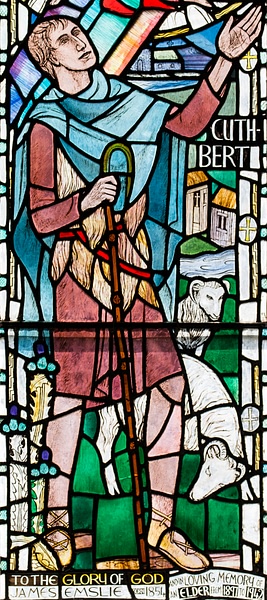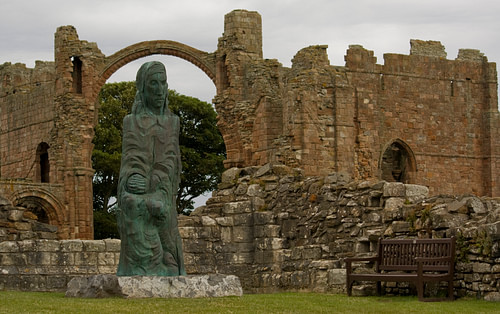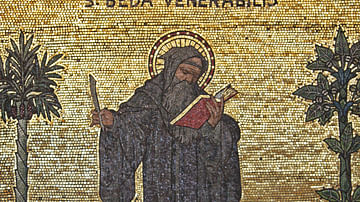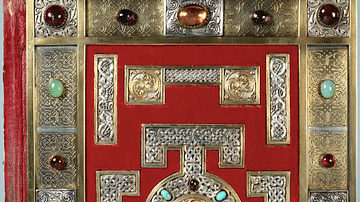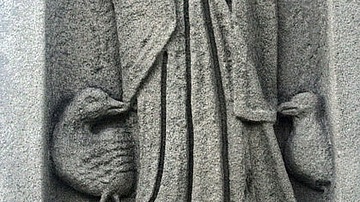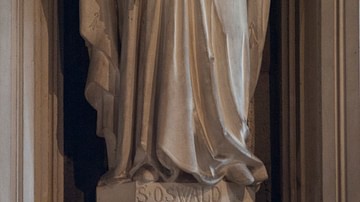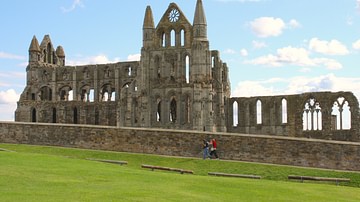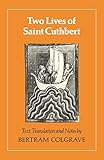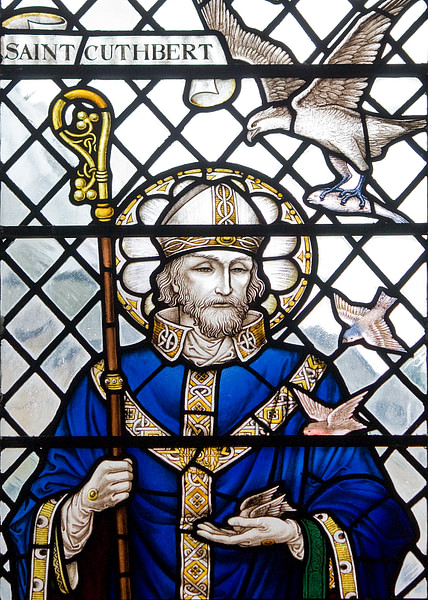
Saint Cuthbert (c. 634 - 20 March 687) was an Anglo-Saxon monk from the Kingdom of Northumbria, who became the bishop of Lindisfarne and one of the most important saints of the medieval church in England.
He first became a monk at Melrose c. 651 and later spent time in the communities at Ripon and Lindisfarne. He retired to the island of Farne around 676 to lead a life of solitude but was offered a bishopric in 684. He was reluctant to leave his hermitage, but after a visit from King Ecgfrith (r. 679-685) himself, Cuthbert was persuaded to accept the new position and was named bishop of Lindisfarne. Already renowned during his life for his miracles and piety, after death Cuthbert became the patron saint of Northumbria.
Cuthbert’s life is recounted in four important works dating to a decade or two after his death. Later narratives of his life are largely drawn from these works. The earliest of these was written by an anonymous monk of Lindisfarne probably no later than 705. Three others were written by Bede: one in verse, another in prose, and an account of Cuthbert’s life in his Ecclesiastical History of the English People. Both Bede and the anonymous Lindisfarne biographer draw on first-hand accounts from those who knew Cuthbert personally. Given the hagiographic nature of these works, it can be difficult to separate the life of Cuthbert as a historical figure from the legends of his many miracles.
Early Life
Cuthbert was likely born c. 634 or 635 in the Kingdom of Northumbria. The precise location of his birth is uncertain, though he seems to have spent his earliest years in Lothian and Lowland Scotland, which was then Northumbrian territory. Very little is known about his family, though there is some evidence to suggest he had a wealthy background. According to Bede, he grew up behaving much as any other young child: playing games and wrestling with other boys. In his teenage years, he worked as a shepherd and may have spent some time as a soldier.
According to Bede, Cuthbert was eight years old when he began experiencing a series of miracles which ultimately led him to pursue his monastic career. The first of these events occurred when a much younger child approached him and predicted that Cuthbert would one day be consecrated as a bishop and insisted that it was not at all fitting for him to behave like other children. Cuthbert took this child’s words to heart and made up his mind to lead a more serious life. Another miraculous event from Cuthbert’s youth involved a painful infection of his knee, which grew so swollen that he could hardly walk. While Cuthbert suffered, a rider approached him on horseback, dressed all in white, and told him how to treat his knee. Cuthbert followed the advice and soon his knee was restored. Afterwards, Cuthbert realized that this rider had been an angel. In yet another episode, Cuthbert encountered a crowd of onlookers taunting a group of monks caught adrift while rafting on the River Tyne. Rather than joining the jeering crowd, Cuthbert knelt down and prayed for the deliverance of the monks who were in danger of drowning. As he prayed, the wind turned and carried the men safely back to shore.
One more miracle occurred in Cuthbert’s youth which seems to have been a final driving force behind his decision to join a medieval monastery. He and a few companions were tending a flock of sheep one night when he witnessed a bright light in the sky and a heavenly choir descending to earth before returning to heaven with a particularly dazzling soul. Cuthbert assured his companions that they must have seen the soul of some saint being led to heaven. The next morning the news arrived that Bishop Aidan of Lindisfarne had passed away that night. Cuthbert immediately decided to pursue a religious career, returned the sheep to their owners, and set off for Melrose to join the monastic community there.
Monastic Career
If Cuthbert really did arrive at Melrose shortly after Aidan’s death, then his monastic career began in late 651. Bede notes that he arrived at Melrose on horseback, with a spear, and in the company of a servant, which would seem to suggest an aristocratic upbringing. At Melrose, Cuthbert first received instruction from Prior Boisil, who apparently foresaw what a holy man Cuthbert would become. Not long after Cuthbert’s arrival, a new abbot, Eata, arrived at Melrose. Boisil told Eata about Cuthbert’s potential, and Eata granted permission for Cuthbert to receive the monastic tonsure.
After approximately seven years at Melrose, Cuthbert accompanied Eata and several other monks to a new monastery at Ripon, which had recently been founded by King Ahlfrith of Deira (r. 655-664). At Ripon, Cuthbert was given the title of guest-master and welcomed a stranger to the abbey whom he offered water for washing and food to eat. The guest at first refused the food, but Cuthbert eventually persuaded him. When Cuthbert returned with the food, he found the guest had gone but had not left any footprints in the snow, and he found several perfectly baked loaves of bread. This proved that the guest had been an angel.
After King Alhfrith seized Ripon and made Wilfrid its new abbot, Cuthbert and many other monks returned to Melrose with Eata. Cuthbert contracted a plague and lay stricken in bed with his brethren praying over him. When he awoke in the morning, he learned that his companions had prayed for his recovery and quickly rose out of bed and resumed his duties. His strength returned to him gradually, but the illness left him with a chronic pain in his right leg that troubled him for the rest of his life.
Boisil predicted that Cuthbert would never again be stricken by illness but also predicted his own death. Following Boisil’s death, Cuthbert succeeded him as Prior of Melrose, led his brethren in the observation of monastic rule, and worked vigorously to convert neighboring peoples to Christianity. Bede writes that many of the people living around Melrose were Christians in name only while others had totally reverted to paganism. Cuthbert traveled far and wide to preach, even to the poorest and most remote villages. He would often be absent from Melrose for weeks at a time.
Cuthbert’s reputation for piety and miracle-working seem to have caught the attention of Northumbrian royalty early in his career. When word of his piety reached the ears of Æbbe, sister of King Oswiu of Northumbria (r. 642-670), she invited him to visit her at her own monastery near Coldingham. While at Melrose, he also exorcised a demon who was tormenting the wife of a royal reeve.
At some point after 664, Eata transferred Cuthbert from Melrose to Lindisfarne, off the coast of Northumbria north of the royal seat of Bamburgh. Eata was by then bishop of Lindisfarne and brought Cuthbert there possibly as a direct result of the Synod of Whitby. Prior to the synod, tensions arose between conflicting factions in the Northumbrian church. At issue were a number of practices, notably the dating of Easter. Since the days of Saint Aidan (d. 651), Lindisfarne had followed the Celtic practice which differed markedly from the Roman practice promoted by now prominent clergymen including Wilfrid. At the synod, King Oswiu sided with the Roman faction, and many proponents of the Celtic tradition left the kingdom in protest. Eata and Cuthbert accepted the king’s decision and remained at Lindisfarne.
While at Lindisfarne, Cuthbert still preached vigorously among the common people in addition to his other duties. He also performed a wide variety of miracles, and his fame for doing so continued to spread. With prayer, he healed the sick, warded off evil spirits, and suppressed fires. He was known to pray for hours, even days at a time, shunning sleep and weeping openly during services.
Hermitage & Bishopric
After over a decade at Lindisfarne, Cuthbert decided to retire to a life of solitude on Farne Island. According to Bede, previous attempts to settle the island had failed as the place was haunted by demons who chased the newcomers away. Cuthbert was undeterred, however, and built himself a dwelling on the island out of wood, turf, and stone. He constructed both a house to live in and a separate building to serve as an oratory. Bede writes that it would normally have taken several men to complete this work, but that Cuthbert was aided by angels as he prepared his new home.
People came from Lindisfarne and from all over Britain to seek his aid with their troubles and afflictions. Among them was Ælflæd, Abbess of Whitby and sister of King Ecgfrith (r. 670-685), who was then suffering from a dangerous illness that had left her unable to walk. Cuthbert sent her a girdle, and when she put it on, she found herself able to walk once more. Not long after, she was fully recovered.
Cuthbert later met Ælflæd in person on an island in the mouth of the River Coquet. Ælflæd asked Cuthbert how long her brother Ecgfrith would rule, and he reluctantly predicted that Ecgfrith would be dead within a year. She despaired that there was no heir, but Cuthbert reminded her of her half-brother Aldfrith, then living in exile "among the islands of the Irish" (Colgrave, 237). Cuthbert also foresaw his own elevation to the rank of bishop: "I know that I am not worthy of such a rank; nevertheless I cannot escape anywhere from the decree of the Ruler of Heaven" (Colgrave 237).
Cuthbert was elected bishop at a synod presided over by King Ecgfrith and Theodore, Archbishop of Canterbury. Cuthbert was reluctant, but a delegation led by King Ecgfrith himself visited him at his hermitage and begged him to accept. Cuthbert was initially offered the bishopric of Hexham but exchanged episcopal sees with Eata. Cuthbert was consecrated at York by Archbishop Theodore in early 685. As bishop, Cuthbert led by holy example. Bede writes:
Gladly and diligently he practised his wonted frugality and, amid the thronging crowds, rejoiced to preserve the rigours of monastic life. He gave food to the hungry, clothing to the suffering, and he was duly adorned with all else that should mark the life of a bishop. And signs and miracles whereby he shone outwardly gave witness to the inward virtues of his mind. (Colgrave 243)
Not long after assuming the bishopric, Cuthbert again prophesied the impending death of King Ecgfrith. While Ecgfrith led an army north against the Picts, Cuthbert visited the queen at a place called Lugubalia, modern-day Carlisle. During his visit, Cuthbert suddenly became troubled in spirit and declared that Ecgfrith had been killed and his army destroyed. News soon arrived that the Picts of Fortriu, led by Bridei mac Bili (r. 672-693), had routed Ecgfrith’s forces at the Battle of Dun Nechtain and that the king had indeed been killed. A short while later, Ecgfrith’s half-brother Aldfrith succeeded him on the throne as Cuthbert had predicted.
Death
Cuthbert soon made another solemn prediction: that of his own approaching death. He had actually predicted his death as early as about 684 when discussing his elevation to the rank of bishop. According to Bede, Cuthbert said:
If He has determined to subject me to so great a burden, I believe that after a short time He will set me free, and perhaps, after not more than two years, He will send me back to my accustomed rest and solitude. (Colgrave, 237).
He predicted his death several more times in the years following the Northumbrian defeat at the Battle of Dun Nechtain. Meanwhile, Cuthbert continued to perform a variety of other miracles as well. He cured the sick, turned water to wine, and witnessed another soul being carried to heaven. Knowing that his death was fast approaching, Cuthbert resolved to return to his hermitage on Farne Island. Before he left, one of his brethren asked when he would return. He replied: "When you bring my body back here" (Colgrave, 271).
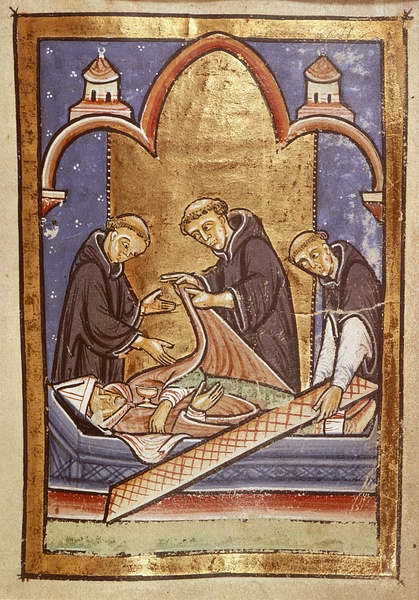
Cuthbert dwelt on Farne for another two months before falling gravely ill. He knew he was dying, and he dictated his wishes to his companions for his burial. Even during his final illness, he continued to miraculously heal his companions. He also exhorted them to continue to observe the Catholic rites, particularly the celebration of Easter, rather than reverting to the Celtic practice.
Cuthbert passed away on 20 March 687. His body was taken by ship back to Lindisfarne where it was received by a host of his brethren and a choir of singers. He was placed in a stone sarcophagus beside the altar in the church of Saint Peter. The many miracles he had performed in life continued well after his death. The water used to bathe his body was mixed with soil and then used to cure a boy who had been tormented by a demon. Another man was cured of an illness after praying at his tomb. Still another man, paralyzed from the waist down, regained the use of his legs after Cuthbert’s shoes were put on his feet. A hermit on Farne Island was cured of horrific swelling and scabbing on his face after washing with a calfskin that had once belonged to the saint. Eleven years after his death, Cuthbert’s tomb was opened so that the brethren of Lindisfarne could move his body. They found the body had not decomposed at all and that it looked as though Cuthbert was sleeping rather than deceased. Even the clothes he wore looked as new as if he had only recently been dressed in them.
Miracles Performed
Cuthbert is remembered by his biographers as a prolific miracle worker. Like many saints before him, Cuthbert was renowned as a healer. He exorcised demons and restored the bodies of the lame or injured. Through prayer or through the blessing of food or drink, Cuthbert cured all manner of illnesses. He also performed a number of miracles involving the sea and other bodies of water. He rescued the monks on the Tyne with prayer before he even received the monastic tonsure. One witness claimed to have seen him wade into the sea at night where "he spent the dark hours of the night watching and singing praises to the sound of the waves" (Colgrave, 189). Afterward, otters appeared to dry him with their fur while he blessed them in return. Cuthbert interceded on more than one occasion during dangerous storms. One storm stranded Cuthbert and his companions while they traveled by boat. After praying, they found cooked dolphin meat to eat, and Cuthbert correctly predicted the storm would end in three days, after which they continued their journey safely. Another storm stranded a group of visitors at his home on Farne Island for seven days until he intervened.
Another common theme among Cuthbert’s miracles is communication with animals. He once correctly predicted that a passing eagle would return with food for him and his companions. On Farne, when birds continually ate the crops he had planted, he told them to stop unless they had God’s permission. After this, they no longer bothered his crop. When ravens continually stole straw from the thatched roofs of his buildings, Cuthbert commanded them to stop in the name of Jesus Christ. Not only did the ravens stop but they also brought Cuthbert and his brethren lard from a hog to grease their shoes.
Legacy
After his death, Cuthbert’s cult was vigorously promoted by the Northumbrian church with the enthusiastic support of the royal family. Eadhbert, probably Cuthbert’s immediate successor as bishop of Lindisfarne, was buried in Cuthbert’s original grave as a sign of his love of the saint. Eadfrith, who became bishop of Lindisfarne c. 698, commissioned three of the best-known lives of Saint Cuthbert. The first was likely that of the anonymous Lindisfarne author and the other two, one written in prose and one in verse, were both written by Bede. Eadfrith is also remembered for creating the Lindisfarne Gospels "for God and Saint Cuthbert", according to a later inscription on the book.
It is likely that Bede himself is at least partially responsible for the spread of Cuthbert’s fame throughout Northumbria and beyond. Bede himself mentions, in his verse life, that Cuthbert was already regarded as a patron saint of Northumbria at the time of his writing, but Bede’s own prominence likely helped spread the cult’s fame farther still. In subsequent centuries, rulers of the southern English kingdoms held Cuthbert in high esteem. Alfred the Great (r. 871-899) began a long association between Cuthbert's cult and the royal family of Wessex after he was inspired by a vision of the saint during his struggles against the Danes. At least two of Alfred’s descendants, Æthelstan (r. 924-927) and Edmund (r. 939-946), visited Cuthbert’s shrine bearing lavish gifts. Even a Viking king of York, Guthred (r. 883-895), patronized the cult, endowing the community with lands around the town of Chester-le-Street. Cuthbert’s reputation as one of Britain’s most important saints persevered centuries after the Norman Conquest of England. Monarchs, bishops, and popes visited his shrine. Miracles were recorded at the shrine until the Dissolution of the Monasteries in the 16th century.
